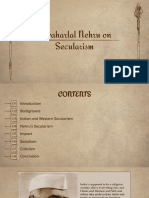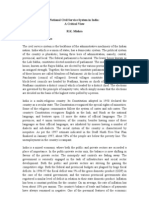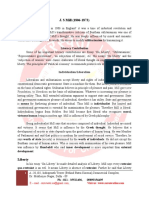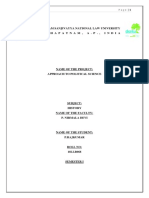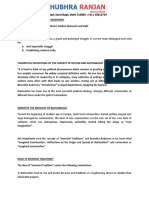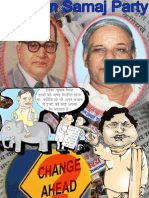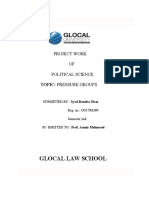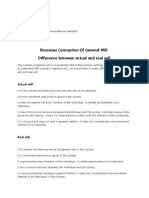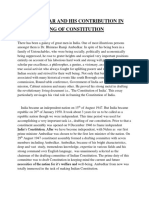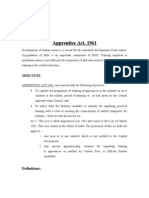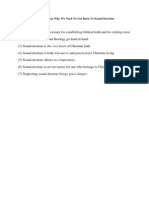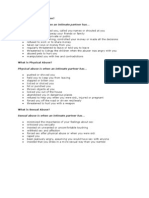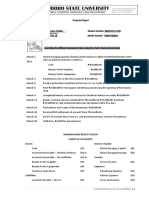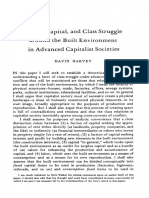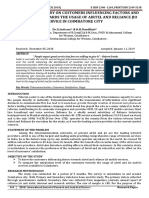0 ratings0% found this document useful (0 votes)
212 viewsUNIT - V - Welfare State
UNIT - V - Welfare State
Uploaded by
Samuel RajThe document discusses the concept of a welfare state. It defines a welfare state as a form of government that protects and promotes citizens' economic and social well-being based on principles like equal opportunity and equitable distribution of wealth. A welfare state assumes responsibility for citizens' access to basic resources like housing, healthcare, education and employment. It also regulates economic activities and ensures citizens' access to public services and financial assistance. India is provided as an example of a welfare state based on provisions in its constitution.
Copyright:
© All Rights Reserved
Available Formats
Download as PPTX, PDF, TXT or read online from Scribd
UNIT - V - Welfare State
UNIT - V - Welfare State
Uploaded by
Samuel Raj0 ratings0% found this document useful (0 votes)
212 views14 pagesThe document discusses the concept of a welfare state. It defines a welfare state as a form of government that protects and promotes citizens' economic and social well-being based on principles like equal opportunity and equitable distribution of wealth. A welfare state assumes responsibility for citizens' access to basic resources like housing, healthcare, education and employment. It also regulates economic activities and ensures citizens' access to public services and financial assistance. India is provided as an example of a welfare state based on provisions in its constitution.
Original Title
UNIT – V - Welfare state.pptx
Copyright
© © All Rights Reserved
Available Formats
PPTX, PDF, TXT or read online from Scribd
Share this document
Did you find this document useful?
Is this content inappropriate?
The document discusses the concept of a welfare state. It defines a welfare state as a form of government that protects and promotes citizens' economic and social well-being based on principles like equal opportunity and equitable distribution of wealth. A welfare state assumes responsibility for citizens' access to basic resources like housing, healthcare, education and employment. It also regulates economic activities and ensures citizens' access to public services and financial assistance. India is provided as an example of a welfare state based on provisions in its constitution.
Copyright:
© All Rights Reserved
Available Formats
Download as PPTX, PDF, TXT or read online from Scribd
Download as pptx, pdf, or txt
0 ratings0% found this document useful (0 votes)
212 views14 pagesUNIT - V - Welfare State
UNIT - V - Welfare State
Uploaded by
Samuel RajThe document discusses the concept of a welfare state. It defines a welfare state as a form of government that protects and promotes citizens' economic and social well-being based on principles like equal opportunity and equitable distribution of wealth. A welfare state assumes responsibility for citizens' access to basic resources like housing, healthcare, education and employment. It also regulates economic activities and ensures citizens' access to public services and financial assistance. India is provided as an example of a welfare state based on provisions in its constitution.
Copyright:
© All Rights Reserved
Available Formats
Download as PPTX, PDF, TXT or read online from Scribd
Download as pptx, pdf, or txt
You are on page 1of 14
UNIT – V - Welfare state
The welfare state is a form of government in which the state protects
and promotes the economic and social well-being of the citizens,
based upon the principles of equal opportunity, equitable distribution
of wealth, and public responsibility for citizens unable to avail
themselves of the minimal provisions for a good.
A welfare state is a social system in which the government assumes
responsibility for the well-being of citizens by making sure that people
have access to basic resources such as housing, health care, education,
and employment.
UNIT – V - Welfare state
What are the distinct Features of a Welfare State?
•An Instrument for Social Welfare:
•A Compromise between Individualisms and Socialism:
•Establishment of Democracy:
•Equal Rights of All:
•Development through Planning:
•Moral Development of Individual:
•A Positive State:
•Social welfare is the Right of Individual, not a Dole from the State:
UNIT – V - Characteristics of welfare state
1.A welfare state ensures social security. In a welfare state of economy, though the traits of
capitalism are also seen, it is mainly a mixed economy. Even when a combination of
capitalistic and socialistic features exists, the government plays a dominant role in controlling
the economic activities and in the social welfare of the people.
2.A welfare state is socialistic in nature. It is based on the principles of equality and is keen to
provide equal opportunity to all. It also aims to ensure equitable distribution of wealth.
3.It exercises control over all the economic activities. In a welfare state, all the private
enterprises are regulated by the government.
4.It provides even the basic facilities to its citizens. Furnishing services to each and every
individual is its duty. A welfare government is keen in providing economic and social services
such as general education, public health, public transport, housing, and other financial
assistance to its people.
5.It undertakes and runs various enterprises. Ownership and operation of industrial
enterprises, business and other commercial activities are also done by welfare governments.
UNIT – V - Characteristics of welfare state
6.It ensures justice to all. In a welfare state, common man has to deal with the authorities for
many of their needs. For example; administrative officers, controlling officers, sanctioning
authorities, officers of social services, executives of public sector undertakings etc. In all such
dealings, a welfare state has the responsibility to ensure justice and fulfillment of their
requirements.
7.Planning of activities: Economic activities include production and distribution. It is the duty
of the welfare state to formulate national policies and to plan every economic activity in a
balanced manner. Industrial policy, trade policy, commercial and banking policy etc are
framed in order to control those activities.
8.It is the function of a welfare state to regulate and control all private enterprises engaged in
economic activities. Such control includes registration, licensing, taxation etc.
9.Welfare of labourers also comes under the purview of the duties of welfare state. They are
bound to make legislations to prevent exploitation of workers, and to ensure the security and
welfare of those who work in industrial enterprises, factories, companies and all other sectors
of employment.
UNIT – V – India is a welfare state
As we have seen, India is described as a welfare state. ... A welfare
state is based on the principles of equality of opportunity and
equitable distribution of wealth. It also focuses on the governmental
responsibility for those who are unable to avail themselves of the
minimal provisions of a good life.
What are the provisions in the Constitution of India that make it a
welfare state?
The Directive Principles of State Policy, enshrined in Part IV of
the Indian Constitution reflects that India is a welfare state. Seats
are reserved for scheduled castes and scheduled tribes in government
jobs, educational institutions, Lok Sabha and Vidhan Sabha.
UNIT – V – India is a welfare state
India is called a welfare state:
That is why, they decided that India would be a welfare state. As you
must have seen, India is described as a “sovereign socialist secular
democratic republic” in the Preamble of the Indian Constitution.
Accordingly, the Constitution has extensive provisions to ensure
social and economic welfare of the people of India.
Welfare state and its functions:
Welfare state, concept of government in which the state or a well-
established network of social institutions plays a key role in the
protection and promotion of the economic and social well-being of
citizens. ... The general term may cover a variety of forms of
economic and social organization.
UNIT – V – Social Change
Social Change
Change means differentiation in anything observation over sometime. If
we feel that there's come alteration we call it changes. It this change is in
contest to social structure, institution etc, i.e. social context then it is
social change.
According Fictor "Change means variations from previous state or mode
of existence".
Change is an universal phenomena i.e. it is a law of native. There's
always a change in nature. Society is a part of nature & so society also
changes & static society is unthinkable. Society is on the wheel of
change, which may occur due to various factors (like demography, ideas
etc. If there is any change in Technology etc there's change in society) out
the change varies in speed & farm.
UNIT – V – Definition of Social Change
Ginsberg (By social change I understand a change in the social structure).
Kingsley Doris "By social change is meant only such alternations as occur in social
organization i.e. the structure & functions of society".
Merril & Elbridge "Social change means, that large no. of persons are engaging in
activities that differ from those which they or their immediate fore-fathers engaged
in some time before."
Gillin & Gillin "Social changes are variations from the accepted mode of life,
whether due to alteration in geographical condition, in cultural equipment,
composition of the population. Or ideologies & whether brought about by diffusion
or inventions within the group."
Jones' "Social change is a term used to describe variations in or modification of any
aspect of social process, social patterns, social interaction or social organization."
M.D.Jenson – Describes –Social change as "modification in ways of doing &
thinking of people."
UNIT – V – Characteristics of Social change
• Social change is universal or it is an essential law.
• Change with diff. in speed & form simple society … change was slower.
• Change is unpredictable in general Revolt is a process of social change. What speed & in
what form the change takes place is not easily predictable.
• Social change is change in community
• Social change generally changes in direction.
There are 3 patterns of social change.
•linear failure change generally leads to progress (change for good) can't cycle –car –
train –plain
•Fluctuating change – the change may be upward & downward. The demographic
change is such also economic change,
•Cyclical change – the change is in a cycle. Fashion, sometimes also in economical
aspect (Karl max gave this idea. He says earlier there was no private property & we may
go back to it).
UNIT – V – Type of Social Change:
(1) Evolutionary Social Changes:
(2) Revolutionary Changes:
(i) Social Movement and Social Revolution:
(ii) Common Motivation:
(iii) Common Need:
(iv) Long Standing Suffering due to Suppression and Oppression:
(v) Impact of Communication:
(vi) Education:
UNIT – V – Type of Social Change:
Types of social change: According to cultural anthropologist David F.
Aberle, the four types of social change include:
Alternative
Redemptive
Reformative
Revolutionary
Definition: Social change is any alteration in the cultural, structural,
population, or ecological characteristics of a social system. In a sense,
attention to social change is inherent in all sociological work
because social systems are always in the process of change
UNIT – V – Theories of Social Change:
Theory of Deterioration:
Some thinkers have identified social change with deterioration. According to them,
man originally lived in a perfect state of happiness in a golden age. Subsequently,
however, deterioration began to take place with the result that man reached an age of
comparative degeneration. This was the notion in the ancient Orient.
It was expressed in the epic poems of India, Persia and Sumeria. Thus, according to
Indian mythology man has passed through four ages—Satyug, Treta, Dwapar and
Kaliyug. The Satyug was the best age in which man was honest, truthful and
perfectly happy.
Thereafter degeneration began to take place. The modern age is the age of Kaliyug
wherein man is deceitful, treacherous, false, dishonest, selfish and consequently
unhappy. That such should be the concept of history in early times is
understandable, since we observe deterioration in every walk of life today.
UNIT – V – Theories of Social Change:
Cyclic Theory:
Another ancient notion of social change found side by side with the afore-mentioned one, is
that human society goes through certain cycles. Looking to the cyclic changes of days and
nights and of climates some sociologists like Spengler believe that society has a
predetermined life cycle and has birth, growth, maturity, and decline.
Modern society is in the last stage. It is in its old age. But since history repeats itself, society
after passing through all the stages, returns to the original stage, whence the cycle again
begins. This concept is found in Hindu mythology, a cording to which Satyug will again start
after Kaliyug is over. J.B. Bury in his The Idea of Progress, pointed out that this concept is
also found in the teachings of stoic philosophers of Greece as well as in those of some of the
Roman philosophers, particularly Marcus Aurelius.
The view that change takes place in a cyclical way has been accepted by some modern
thinkers also who have given different versions of the cyclical theory. The French
anthropologist and biologist Vacher de Lapouge held that race is the most important
determinant of culture. Civilization, he maintained, develops and progresses when a society is
composed of individuals belonging to superior races and declines when racially inferior
people are absorbed into it.
UNIT – V – Theories of Social Change:
Linear Theory:
Some thinkers subscribe to the linear theory of social change. According to them,
society gradually moves to an even higher state of civilization and that it advances
in a linear fashion and in the direction of improvement. Auguste Comte postulated
three stages of social change: the Theological, the Metaphysical and the Positive.
Man has passed through the first two stages, even though in some aspects of life
they still prevail, and is gradually reaching the Positive stage. In the first stage man
believed that supernatural powers controlled and designed the world. He advanced
gradually from belief in fetishes and deities to monotheism.
This stage gave way to the Metaphysical stage, during which man tries to explain
phenomena by resorting to abstractions. On the positive stage man considers the
search for ultimate causes hopeless and seeks the explanatory facts that can be
empirically observed. This implies progress which according to Comte will be
assured if man adopts a positive attitude in the understanding of natural and social
phenomena.
You might also like
- High School Football Stadium Project PlanDocument12 pagesHigh School Football Stadium Project Planseanakim68% (19)
- Info Millions CourseDocument242 pagesInfo Millions Coursebeam2611No ratings yet
- DYSON ReportDocument14 pagesDYSON ReportMingzhe wangNo ratings yet
- Welfare StateDocument38 pagesWelfare StateSARIKANo ratings yet
- Public Administration in Developing WorldDocument5 pagesPublic Administration in Developing WorldNikita ChoudhuryNo ratings yet
- IPT - Nehru On SecularismDocument22 pagesIPT - Nehru On Secularism20527059 SHAMBHAVI TRIPATHI100% (1)
- Understanding GandhiDocument122 pagesUnderstanding Gandhihimaniyadav7393No ratings yet
- Nehru SecularismDocument6 pagesNehru Secularismshahid afreediNo ratings yet
- The Role of Tilak in Freedom Movement: Bal Gangadhar Tilak, Born As Keshav Gangadhar Tilak (23 JulyDocument12 pagesThe Role of Tilak in Freedom Movement: Bal Gangadhar Tilak, Born As Keshav Gangadhar Tilak (23 JulyAbhinav BhadauriaNo ratings yet
- 26 Jean Jacques Rousseau (1712-1770 A.D.) : Scanned With CamscannerDocument20 pages26 Jean Jacques Rousseau (1712-1770 A.D.) : Scanned With CamscannerShaman KingNo ratings yet
- Jawaharlal Nehru PDFDocument12 pagesJawaharlal Nehru PDFTanishaNo ratings yet
- Representative GovernmentDocument10 pagesRepresentative GovernmentLopamudra MandalNo ratings yet
- Nehru's Views On SocialismDocument1 pageNehru's Views On Socialismlavajyotimissong123No ratings yet
- 'Problem of CommunalismDocument8 pages'Problem of CommunalismShaikh RazzakNo ratings yet
- Dr. Shakuntala Misra National Rehabilitation University Lucknow Faculty of LawDocument10 pagesDr. Shakuntala Misra National Rehabilitation University Lucknow Faculty of LawSaurabh YadavNo ratings yet
- Idea of Equality: Equality As A Statement of Right, Not of FactDocument6 pagesIdea of Equality: Equality As A Statement of Right, Not of FactPranav SharmaNo ratings yet
- Civil Services in IndiaDocument34 pagesCivil Services in IndiaAbhinav GuptaNo ratings yet
- Public Administration Unit-47 Prime Minister's Office and Cabinet SecretariatDocument11 pagesPublic Administration Unit-47 Prime Minister's Office and Cabinet SecretariatDeepika Sharma100% (4)
- What Is LibertyDocument13 pagesWhat Is Libertyabhijeet nafriNo ratings yet
- Political Ideologies of Nehru and His Idea of IndiaDocument23 pagesPolitical Ideologies of Nehru and His Idea of IndiaShantanu Rawat67% (3)
- Thoughts of Jawaharlal NehruDocument2 pagesThoughts of Jawaharlal Nehruanonymous 212No ratings yet
- Jharkhand Startup Policy 2016Document35 pagesJharkhand Startup Policy 2016anupsiddharth2No ratings yet
- J S Mill PDFDocument6 pagesJ S Mill PDFAjita Yadav100% (1)
- Liberalism Upsc Notes 16Document3 pagesLiberalism Upsc Notes 16Sk SharmaNo ratings yet
- Jawaharlal NehruDocument7 pagesJawaharlal NehruThermo MadanNo ratings yet
- Unit Iii: Indispensability of JusticeDocument18 pagesUnit Iii: Indispensability of JusticeL. ThongzNo ratings yet
- Aurobindo 1683914472Document9 pagesAurobindo 1683914472YOGESH YADAVNo ratings yet
- Unit 1 To 11Document145 pagesUnit 1 To 11VkNo ratings yet
- Approach To Political ScienceDocument17 pagesApproach To Political ScienceRandy Raj OrtonNo ratings yet
- Nature of Comparative PoliticsDocument2 pagesNature of Comparative PoliticsShaik AfzalNo ratings yet
- POSDCORB - Wikipedia, The Free EncyclopediaDocument5 pagesPOSDCORB - Wikipedia, The Free EncyclopediaRahul SonavaneNo ratings yet
- Handout 5-Sir SyedDocument5 pagesHandout 5-Sir SyedARZOONo ratings yet
- Perspectives On National MovementDocument19 pagesPerspectives On National MovementShashank Shekhar SinghNo ratings yet
- Political SC Sem 3Document20 pagesPolitical SC Sem 3Ayush ShivhareNo ratings yet
- CC-5, Unit 1 Ancient Indian Political Thought Overview, Ideas On Brhamanic and Shramanic TraditionsDocument22 pagesCC-5, Unit 1 Ancient Indian Political Thought Overview, Ideas On Brhamanic and Shramanic TraditionsApratim DuttaNo ratings yet
- Aristotle Thoery of JusticeDocument1 pageAristotle Thoery of Justicexee shanNo ratings yet
- Baps 12 Block 01Document33 pagesBaps 12 Block 01Vian BhiniNo ratings yet
- Course Name-B.A.L.L.B.Ivth Sem Subject - Sociology Teacher - Dr. Niru Jain Topic - Sanskritization, Westernization, ModernizationDocument24 pagesCourse Name-B.A.L.L.B.Ivth Sem Subject - Sociology Teacher - Dr. Niru Jain Topic - Sanskritization, Westernization, ModernizationClark KennttNo ratings yet
- Neo Gandhian Approach To Civil DisobedienceDocument1 pageNeo Gandhian Approach To Civil Disobedienceamanshukla6655No ratings yet
- Q) Discuss Kautilya's Views On Theory of State. How It Is Relevant Today?Document4 pagesQ) Discuss Kautilya's Views On Theory of State. How It Is Relevant Today?surbhi sharmaNo ratings yet
- Bahujan Samaj PartyDocument37 pagesBahujan Samaj PartyRishikesh ThakurNo ratings yet
- Glocal Law School: Project Work OF Political Science Topic: Pressure GroupsDocument9 pagesGlocal Law School: Project Work OF Political Science Topic: Pressure GroupsSyed renobaNo ratings yet
- ShukranitiDocument13 pagesShukranitiAkanksha DeepNo ratings yet
- Aurobindo PDFDocument11 pagesAurobindo PDFAshok SutharNo ratings yet
- Federation and ConfederationDocument3 pagesFederation and ConfederationMirza Mohammad Hasan100% (1)
- Rousseau General Will-1Document5 pagesRousseau General Will-1Ammara RiazNo ratings yet
- Aristotle: Aristotle's Life and InfluenceDocument13 pagesAristotle: Aristotle's Life and InfluenceShambhavi YadavNo ratings yet
- AUGUST COMTE (1798 - 1857) : Thinkers BackgroundDocument9 pagesAUGUST COMTE (1798 - 1857) : Thinkers BackgroundRaviNo ratings yet
- Ziauddin Baranis Ideal Sultan and IdealDocument5 pagesZiauddin Baranis Ideal Sultan and IdealFaizan MisbahuddinNo ratings yet
- Human Development in IndiaDocument13 pagesHuman Development in IndiaMohit PaswanNo ratings yet
- Ambedkar and His Contribution in Making of ConstitutionDocument4 pagesAmbedkar and His Contribution in Making of Constitutionsairahul puppalaNo ratings yet
- Niccolo MachaivelliDocument14 pagesNiccolo MachaivelliImti LemturNo ratings yet
- Assignment Elite TheoryDocument8 pagesAssignment Elite TheoryMD. HOSSAIN AHMEDNo ratings yet
- Continuity in Indian AdministrationDocument4 pagesContinuity in Indian AdministrationKailash NagarNo ratings yet
- BA 2ND (Political Science) Political ThoughtDocument168 pagesBA 2ND (Political Science) Political ThoughthariNo ratings yet
- Modern History - U06 - CH03 - Moderate Phase - CH04 - Rise of ExtremistsDocument13 pagesModern History - U06 - CH03 - Moderate Phase - CH04 - Rise of ExtremistsNandNo ratings yet
- Indian SecularismDocument6 pagesIndian Secularismpraneel singhNo ratings yet
- Communism of Property and WivesDocument7 pagesCommunism of Property and WivesUDAY MAHESHWARI100% (1)
- Behavioural ApproachDocument4 pagesBehavioural ApproachNoorain WNo ratings yet
- AggannasuttaDocument2 pagesAggannasuttaARSHIYA ANJUM HU21POLS0100006No ratings yet
- Public Policy Term PaperDocument6 pagesPublic Policy Term PaperAmrita AroraNo ratings yet
- Apprentice Act 1961Document5 pagesApprentice Act 1961sisay2001No ratings yet
- Ehd CQ Fs Eltpny Cyhtp CQ Fs Njtdhapug NGD Epq Fs VD (Dkhapug GPH FsDocument1 pageEhd CQ Fs Eltpny Cyhtp CQ Fs Njtdhapug NGD Epq Fs VD (Dkhapug GPH FsSamuel RajNo ratings yet
- Seven Reasons Why We Need To Get Back To Sound DoctrineDocument1 pageSeven Reasons Why We Need To Get Back To Sound DoctrineSamuel RajNo ratings yet
- Importance of Review of LiteratureDocument5 pagesImportance of Review of LiteratureSamuel Raj100% (3)
- Emotional Abuse Is When An Intimate Partner Has..Document1 pageEmotional Abuse Is When An Intimate Partner Has..Samuel RajNo ratings yet
- The Mines ActDocument33 pagesThe Mines ActSamuel RajNo ratings yet
- NamesDocument2 pagesNamesSamuel RajNo ratings yet
- Performance Improvement and Appraisal For EmployeesDocument26 pagesPerformance Improvement and Appraisal For EmployeesSamuel RajNo ratings yet
- S.Rengasamy Madurai Institute of Social Sciences Compiled byDocument54 pagesS.Rengasamy Madurai Institute of Social Sciences Compiled bySamuel RajNo ratings yet
- Banco de Preguntas Práctica Calificada 2 Elementary Business EnglishDocument11 pagesBanco de Preguntas Práctica Calificada 2 Elementary Business EnglishAraceli Maryori Calderon PonceNo ratings yet
- 1Z0-068 - Oracle Database 12c: RAC and Grid Infrastructure AdministrationDocument5 pages1Z0-068 - Oracle Database 12c: RAC and Grid Infrastructure AdministrationBEPRASANNA@GMAIL.COMNo ratings yet
- State of Gen Z 2021 2022 Looking AheadDocument23 pagesState of Gen Z 2021 2022 Looking Aheadvascosemedo725No ratings yet
- Case Study - RubanP - M2C1068Document2 pagesCase Study - RubanP - M2C1068Agastin RubanNo ratings yet
- (Last Name, Given Name, Middle Name) : Wonderland Beauty Salon Chart of Accounts Assets Owner's EquityDocument9 pages(Last Name, Given Name, Middle Name) : Wonderland Beauty Salon Chart of Accounts Assets Owner's EquityDe chavez, John carlo R.No ratings yet
- Generic Production Process Control Requirements: GPRO - 039Document40 pagesGeneric Production Process Control Requirements: GPRO - 039santosh kumarNo ratings yet
- Enbaling Out Comes 6 (Hbo)Document2 pagesEnbaling Out Comes 6 (Hbo)Nabongs AegyooNo ratings yet
- 184 - Use of English Vocabulary Test HDocument7 pages184 - Use of English Vocabulary Test HІрина ВичужанінаNo ratings yet
- Infineon-STM System Time 1 KIT TC375 LK-Training-v01 00-ENDocument8 pagesInfineon-STM System Time 1 KIT TC375 LK-Training-v01 00-ENJulio Cesar Tapia ReyesNo ratings yet
- DIAGNOSTIC TEST in TLE AGRI GRADE 6Document5 pagesDIAGNOSTIC TEST in TLE AGRI GRADE 6Rosemelyn AsuncionNo ratings yet
- TIE6134201508 Operations ManagementDocument3 pagesTIE6134201508 Operations Managementtafara mundereNo ratings yet
- Root Cause Analysis Chart 1Document1 pageRoot Cause Analysis Chart 1sk sajidNo ratings yet
- Harvey D Labor Capital and Class Struggle Around The Built Environment in Advanced CapitalistDocument31 pagesHarvey D Labor Capital and Class Struggle Around The Built Environment in Advanced CapitalisthurdleNo ratings yet
- BNG OB Case 3Document2 pagesBNG OB Case 3Senthil KumarNo ratings yet
- Economics 2021-2022Document96 pagesEconomics 2021-2022PraveenNo ratings yet
- Syllabus: 34 Mid Career Management CourseDocument46 pagesSyllabus: 34 Mid Career Management CourseSaad SuhailNo ratings yet
- M Srinivas Mouli Resume Compressed Compressed Compressed PDFDocument3 pagesM Srinivas Mouli Resume Compressed Compressed Compressed PDFRajeev MisraNo ratings yet
- Liability Waiver FormDocument1 pageLiability Waiver Formbob bob0% (1)
- This Study Resource Was: Cash Out Lear Flows FlowsDocument7 pagesThis Study Resource Was: Cash Out Lear Flows FlowsLayNo ratings yet
- ProjectDocument8 pagesProjectSharan SharanNo ratings yet
- Bar CodeDocument6 pagesBar CodeAkashNo ratings yet
- Assessment in Income TaxDocument3 pagesAssessment in Income Taxayush sikkewalNo ratings yet
- MGT162 - Group ASSIGNMENTDocument18 pagesMGT162 - Group ASSIGNMENT2023801626No ratings yet
- Compilation of Rulings and - Judgments in FOI Cases in NigeriaDocument272 pagesCompilation of Rulings and - Judgments in FOI Cases in Nigeriamichael okekeNo ratings yet
- Mutual Fund Investment How To Multiply Money Create Wealth (Anil G. Rane) (Z-Library)Document125 pagesMutual Fund Investment How To Multiply Money Create Wealth (Anil G. Rane) (Z-Library)swaminathan sureshNo ratings yet
- FN202 Seminar Qns Set 4 Dividend Decision 2018Document3 pagesFN202 Seminar Qns Set 4 Dividend Decision 2018Tonie NascentNo ratings yet
- INFO6005: Business Processes & Security PoliciesDocument65 pagesINFO6005: Business Processes & Security Policiesnareshchat7249No ratings yet





